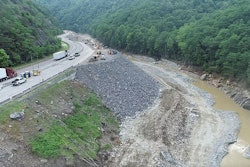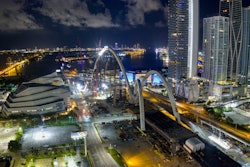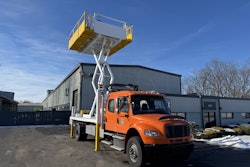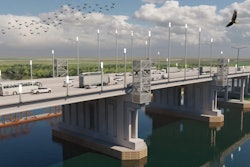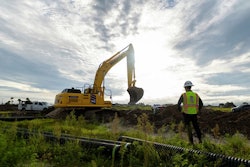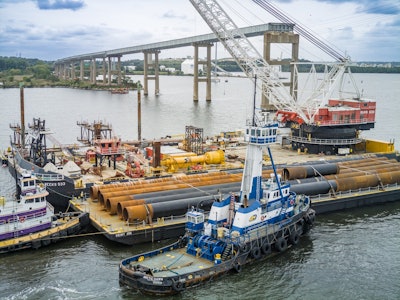
Progress on rebuilding Baltimore’s Francis Scott Key Bridge recently hit a new milestone as the Maryland Transportation Authority began the bridge’s Test Pile Program.
Six test piles, measuring 8 feet in diameter, over 220 feet high and made of American steel, were barged into the city. They vary in thickness from 1.5 inches to 2 inches and will be driven into the Patapsco River – after being vibrated into place – with a pile driving hammer.
For a video showing the test piles and explaining their installation process, scroll to the end of this video.
Some will be evaluated for their potential to be included in the final rebuild of the Key Bridge.
The test pile program consists of the following steps:
- The piles will be lifted into position using a crane and tripping barge.
- The piles will be placed in a template and stabilized with a vibratory hammer.
- The piles will be driven into the riverbed with a hydraulic hammer.
- The load frame will be placed on the six piles and exert vertical and horizontal pressure.
- Instruments on the piles and equipment will report out data to ensure the design models are accurate.
A total of 12 test piles will be placed in the riverbed over the next 6 to 8 weeks and will require about 2 hours of hammering, which will sound similar to a large bell ringing in the distance, according to MDTA.
The collapse of the Key Bridge on March 26, 2024, killed six construction workers and injured two more after the ship Dali lost power and crashed into the bridge.
The Dali’s crash was caused, according to the state, by two electrical power failures that cut propulsion and its ability to steer. Additionally, a series of other errors – including failing backup equipment, the crew’s failure to restore power and the pilots’ requests not followed in time – contributed to the crash. The state alleges the ship's management and crew intentionally circumvented critical safety features.
Demolition of the Key Bridge's remains began in July and is expected to take several months, according to MDTA. The bridge deck over the river will be removed, followed by demolition of sections over Hawkins Point and Sollers Point. The final portion of this first phase of demolition will remove the north and south abutments.
Kiewit Infrastructure Co. won the $73 million Phase 1 Progressive Design-Build contract for the Baltimore bridge replacement in September 2024.

